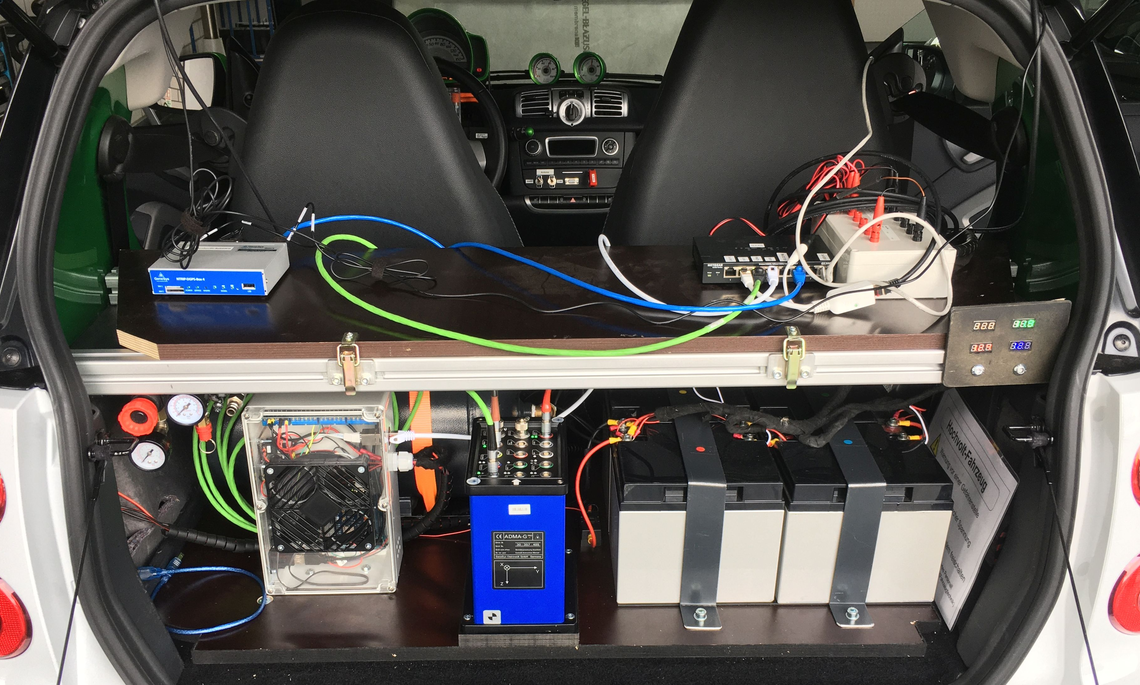CARISSMA's outdoor test facility, located in the northeast of Ingolstadt, is used for tests with vehicles and dummies of road users. Such tests are required for the development of methods, algorithms and components as well as for their validation. The use of the systems under real conditions is intended to ensure that they are suitable for applications in vehicle safety.
Objectives and Ideas
The outdoor test facility takes into account current and future developments in the field of integrated vehicle safety, e.g. by carrying out tests in the speed range up to 80 km/h and transverse dynamic tests under real environmental conditions. New driver assistance systems and, in future, automated vehicles will lead to changes in road traffic. This also requires the development of new test methods. The possibility of reproducibly carrying out critical and thus relevant traffic scenarios will make a significant contribution to this. Data-based methods play an increasingly important role in the development of safety systems for accident prevention, e.g. in sensor signal processing and in algorithms for path planning and vehicle control. In addition to simulation data, a large amount of real data from critical traffic situations is required. Such data are generated on the test facility.
Equipment
- Acceleration area with turning bay (210 m x 15 m)
- Dynamic area (60 m x 70 m)
Equipment:
- Video and loudspeaker system, traffic signs, traffic lights, traffic cones, etc.
- Operation possible in winter in snow conditions
For the manufacturer-independent execution of automated, reproducible driving maneuvers, the researchers have systems at their disposal for taking over the vehicle's longitudinal and lateral guidance. This involves the use of mechanical actuators that operate both the steering and the pedals. For unmanned tests, a redundant, remote-controlled emergency braking system is used, which guarantees a safe vehicle stop. The vehicle motion data required for the control system is provided by an appropriate external inertial sensor system. No structural modifications are required to install the systems, regardless of the vehicle type. In addition, even with the systems installed, a human driver can drive the test vehicle.
- Measurement equipment:
- DGPS base station
- Vehicle: ADMA-G GNSS inertial system, Correvit S-Motion, cameras, lidar sensors
- Infrastructure: cameras, lidar sensors, UAS (multicopter)
- SP80 GNSS tracker
- Softcrashtargets:
- 4activeC2
- Self-built vehicle target
- 4activeBS-adult
- 4activePA-adult
- 4activePA-child, 4activePS-child
- 4activePS-infant 2years (optional incl. BIG-Bobby-Car)
- Dummy movement:
- Self-developed pulley system for movement of VRU-targets
- Self-developed trailer for movement of Vehicle-Targets
- Lifting platform
- Workspaces
Application examples
- Simulation of complex traffic scenarios for research and testing of new integrated safety concepts and algorithms in the medium and higher speed range
- Recording of sensor and reference data under real environmental conditions for the validation of the vehicle perception
- Recording of sensor and reference data under real environmental conditions for the comparison of different sensor concepts
- Recording of sensor and reference data for the validation of safety systems to protect unprotected road users such as pedestrians, cyclists, skateboarders, etc.
Team
Prof. Dr.-Ing. Michael Botsch
Phone: +49 841 9348-2721
Room: K209
E-Mail: Michael.Botsch@thi.de
Dipl.-Ing. (FH) Michael Weinzierl
Phone: +49 841 9348-3383
Room: P108
E-Mail: Michael.Weinzierl@carissma.eu
Christian Gudera, M.Eng.
Phone: +49 841 9348-6409
Room: P108
Fax: +49 841 9348-996409
E-Mail: Christian.Gudera@carissma.eu











![[Translate to English:] Logo Akkreditierungsrat: Systemakkreditiert](/fileadmin/_processed_/2/8/csm_AR-Siegel_Systemakkreditierung_bc4ea3377d.webp)








![[Translate to English:] Logo IHK Ausbildungsbetrieb 2023](/fileadmin/_processed_/6/0/csm_IHK_Ausbildungsbetrieb_digital_2023_6850f47537.webp)


